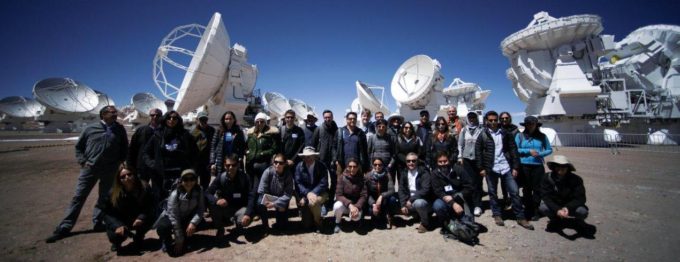21 January, 2020
The ALMA Observatory in San Pedro de Atacama was the chosen site for the Ministers of Science and Economy to join Amazon and Universidad Adolfo Ibañez to present the results of the first year of operations of the Data Observatory, a national scientific data platform that aims to contribute to progress in science, technology, knowledge and innovation.
In an unprecedented partnership between the public and private sector, industry and the academic community, the Data Observatory celebrated its first year of operations from the ALMA Observatory in San Pedro de Atacama, in a ceremony led by the Ministers of Science and Economy, Amazon Web Services and Universidad Adolfo Ibañez to share progress on its new astroinformatics project and invite new strategic partners from Chile and abroad.
As a result of the unparalleled data generation capacity of the ALMA Observatory and the soon to exist NSF Vera Rubin Observatory (VRO – formerly known as the LSST), Chile aims to become the largest Big Data laboratory for astronomy through the foundation of the Data Observatory.
The Data Observatory (DO) is a project led by the Chilean Ministers of Science, Technology, Knowledge and Innovation; and Economy, Development and Tourism; together with Amazon Web Services (AWS) and Universidad Adolfo Ibáñez (UAI). In its first months of operation, it already has preliminary results thanks to its first seed project named Centro Chileno de ALMA (in English, ALMA Chilean Center), which plans in the future to upload astronomic data of international value to the cloud, facilitating its use in astronomy and in applications that contribute to the development of the country.
The DO is an open-source platform, a national facilitator and generator of public assets that invites the participation of the academic community, the public sector, industry and civil society, through the contribution of non-sensitive data (excluding, for example, health and finance), capacities to develop and transfer technology, and specialized human capital training, acting as an innovative development model contributing data to diverse areas of science and the economy.
ALMA records approximately one terabyte of data per shift, while the VRO will generate 40 terabytes each night, representing a massive volume of information that would be distributed globally. This requires technological capacities on par with those used by big streaming companies to distribute multimedia data. Over the last few years, our country has developed experts not only in astronomy, but also in related fields derived from this to address computational challenges generated by this field (astroinformatics), which are relevant to Data Science.
Carlos Jerez, acting CEO for the Data Observatory, remarked that the DO’s access to databases with global value such astronomy and Earth observations, gives it the capability to generate world-class research, education and technological transfer and thereby contribute to sustainable development. “Astronomy is an ideal training field for Chile given the characteristics of the data generated by the observation of the skies, in terms of volume, quality, speed and diversity of this data; but we must focus these mechanisms on Earth to contribute to solutions that address problems such as global warming and water shortage,” he added.
The Minister of Science, Technology, Knowledge and Innovation, Andrés Couve, highlighted that the DO sets the stage to position Chile internationally in data science. “Our scientists currently participate in international collaborations and public knowledge at the highest levels. However, the impact of this research on the country’s sustainable development and social welfare has been insufficient.” Minister Couve added that “a determined participation in the development of large scientific-technological projects is a proven pathway to achieving this impact. Starting in 2020, we will extend open invitations to the academic community, the private sector and civil society to form part of this project and use the data generated in the country for research and entrepreneurship.
According to Julio Pertuzé, representative of the Ministry of Economy, Development and Tourism in the DO, it is in the public interest to “launch projects around generating capacities on data science, artificial intelligence and Big Data, recognizing that technological disruption presents a variety of challenges and opportunities to small countries like Chile. What we lack in the size of our population or technological industries, we make up for in knowledge, human capital and data volume. This enables us to generate an endogenous structure -as a country- in data science. We will concentrate 70% of the astronomic structure in the next decade, which constitutes a major area of scientific data and a large number of astronomers who apply mathematical techniques and replicable algorithms to other industries. We are focusing our efforts to ensure that these capacities are not limited to astronomy and science but extend to technology transference to different areas of the economy and industry, and to entrepreneurs and Chilean society as a whole.”
Jeff Kratz, General Manager of Latin America, Canada & Caribbean Regions, World-Wide Public Sector at Amazon Web Services (AWS), indicated: “The scalability of the data set gathered by the Data Observatory and stored in the AWS cloud infrastructure enables the management of dense and extensive data layers by the scientific community and technology industry in Chile. In little less than a year, since we began the organization, the DO has already replicated the architecture of the ALMA Chilean Center project in the cloud, which makes it possible to publish and democratize previously difficult to access data, which can leverage the progress of multiple sectors of industry in Chile. We are pleased to form part of the founding members.”
Strategic partners of the Data Observatory will participate through the transfer of knowledge and talent, strategic databases, instrumentation and infrastructure -such as laboratories and supercomputers- or by funding innovation projects; all mechanisms under study and open to public and private organisms, universities and foreign organizations. In the future, the DO will also connect to the general public for the purpose of transforming knowledge into something tangible and capturing the democratization of data usage. For this purpose, it is studying the feasibility of projects open to the community with strong public participation such as diverse human-machine, planetary and data laboratory interaction interfaces.
The Data Observatory’s first project is the ALMA Chilean Center, a content delivery and analysis platform provision system based on data generated by the ALMA Observatory. In 5 years, it hopes to incorporate data from other telescopes in the country, primarily the VRO in 2022. Its purpose is to strengthen the local astronomic community, generating synergies in conjunction with other global collaborations in Chile, such as the Chilean Virtual Observatory (ChiVO), the Alerce project of the Millennium Institute of Astrophysics and the Center for Mathematical Modeling.
When operating, the ALMA Chilean Center will provide training for the astronomic community in Chile and Latin America in the implementation of observation projects and access to laboratories to process and analyze data recorded in Chilean facilities. Although ALMA already has regional centers in United States, Germany and Japan, the ALMA Chilean Center will constitute the first of its kind to use cloud technology.
ALMA Deputy Director Speech – Stuartt Corder
First of all, I would like to extend a warm welcome to our visitors from the ministry of economy, development and tourism; the ministry of science, technology, knowledge and innovation; the Data Observatory Foundation; Universidad Adolfo Ibáñez board members; Amazon Web Services representatives; and other distinguished guests.
ALMA is thrilled to host this event and reaffirms our interest in collaborating with the Data Observatory as it moves forward in its foundational project to create a Chilean ALMA Center. Still as in 2018, ALMA is proud to be involved in the start of this remarkable data initiative. The Chilean ALMA Center will improve access to ALMA data, reaching a broader range of the Chilean scientific community. We are confident that this will ultimately enhance the scientific impact of the observatory.
Collaborative efforts between ALMA and the Data Observatory started early in 2019, with Data Observatory staff visiting the ALMA regional centers in East Asia, Europe and North America as well as working directly at the ALMA offices in Chile. This provided a clear picture of community engagement approaches and technical implementation considerations. In 2020, we look forward to finalization of the Memorandum of Agreement that will formalize the relationship between our institutions.
This initiative is another example of the fruitful and mutually beneficial relation we have with Chile. ALMA contributes to local radio astronomy research and discoveries by virtue of the 10% of observing time that goes to the Chilean community. In addition to this, the observatory has established collaborations with several Chilean universities, specifically, Universidad Tecnica Federico Santa Maria, Universidad de Chile, Universidad Adolfo Ibanez and Universidad de la Frontera, for activities ranging from receiving equipment development, the Chilean Virtual Observatory, operations management and antenna control system development.
These efforts have grown human capital and cross-pollinated talent. ALMA and other observatories worldwide have been able to attract and benefit from that talent, which is one of the key goals of the Data Observatory and a value that ALMA shares.
Every year ALMA supports further development of Chilean astronomy through the ALMA-CONICYT Fund and economic and social projects through the ALMA-Antofagasta Regional Fund. Since 2004, ALMA contributions amount to approximately $1M USD per year. This funding has enabled numerous post-docs, astro-engineering and astro-informatics projects at different universities, as well as education and public outreach throughout the country. As a result, the number of astronomers and engineers working at astronomical facilities and Chilean presence in international scientific and engineering forums and conferences has substantially increased. Acknowledging the fact that women are underrepresented in these disciplines, female ALMA scientists and engineers are promoting STEM vocations among girls, acting as powerful and inspiring role models.
Locally, ALMA has supported English and Science education in Toconao since 2009. It has also strengthened cultural ties and interest in STEM among youth in San Pedro county and Magdalena, NM, through student and teacher exchanges. Solar panels in Toconao homes, a cinema in San Pedro, and health and other services, have also been possible thanks to our support.
ALMA reiterates its commitment to support Data Observatory efforts and wishes the foundation success in its endeavors.
Additional Information
ALMA is a partnership between ESO (on behalf of its European Member States), NSF (USA), and NINS (Japan); together with NRC (Canada), MOST and ASIAA (Taiwan), and KASI (Republic of Korea), in cooperation with the Republic of Chile. The Joint ALMA Observatory is operated by ESO, AUI/NRAO, and NAOJ.
The Data Observatory (DO) is a public-private non-profit partnership created by the Ministry of Economy, Ministry of Science, Amazon Web Services (AWS) and Universidad Adolfo Ibáñez (UAI) and its mission is to acquire, process, store and share data sets to contribute to the development of science, technology, innovation, knowledge and economic development due to its volume, nature and complexity. The DO will begin to work with astronomical data and from there expand to other data sets, with the aim to break down barriers and generate the greatest value possible.













